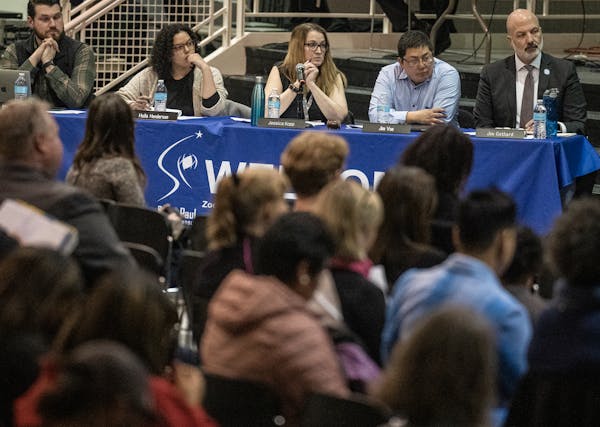At Gordon Parks High School in St. Paul, Principal Shandyn Benson has a desk in the hallway and an iPad at the ready.
With her device, she can see whether a student getting a drink of water or hitting the restroom has permission to do so — or is returning to class quickly enough if they do.
Forget about kids raising their hands to seek a teacher's permission to leave — then getting a handwritten note to step out of the room. Now they use one-click SmartPass digital hall pass technology. Once students are approved for a pass, Benson and other staffers can be on the lookout for any slipups and safety concerns, and keep students on track.
"It is a move forward," Adam Kunz, an assistant superintendent for St. Paul Public Schools, said last week of the system. "Dynamic and more responsive."
This year, SmartPass has been installed in every St. Paul school with grade six and up at an annual cost of about $30,000, Kunz said.
Nationally, the system is used by more than a million students and educators in more than 1,000 schools, according to the company's website. Outside the metro area, for example, the Lake Superior School District has adopted the technology, and posted a YouTube video link for students on how to use it.
But St. Paul, perhaps more than most, had big reasons to make the digital switch.
What's the issue with St. Paul's hallways?
In February, one Harding High student fatally stabbed another in a hallway, and when the school reopened, students could not access the spaces during class time without a chaperone — an arrangement that lasted about two weeks, district spokeswoman Erica Wacker said last week.
Survey results presented to school board members last spring showed that while most St. Paul high school students perceived their schools to be safe, about 23 % felt unsafe or very unsafe in the hallways. Nearly 80 % of high school staff members said they experienced or witnessed physical violence.
The Harding stabbing occurred during passing time between classes, but when officials presented the survey findings in May, they touted the use of digital hall passes as a new strategy to improve school safety.
How does the SmartPass work?
In the tutorial posted by the Lake Superior district, students use their digital device to establish where in the building they are at the time of an out-of-class request and then click to say where they want to go.
Gordon Parks still has students seek verbal permission to leave the room, but they then go to a "kiosk" near the classroom door to enter their ID and where they're headed.
A five-minute countdown begins to get there and back.
Kunz said the system is a great management tool for teachers who otherwise would have to stop class and write passes — cutting into instructional time.
At the same time, students in need of special services, such as counseling or nurse visits, can have requests approved in a potentially smoother way, he said.
Are a student's movements tracked?
No, SmartPass does not have a GPS component.
But if an administrator or other staffer sees a student wandering the hall, they can check the digital monitoring system to see where the student should be.
At Gordon Parks, students also are asked to wear lanyards around their necks to show they're approved to be out and about.
If there are three or four students in a hallway, and no one has a SmartPass, there'll be a "different conversation," Kunz said.
What is the district learning?
Benson, as principal, has the ability to cap how many students can be in hallways at specific times, as well as access on the app to know how often and for how long individual students are out of class. Teachers also have access to those individual time tallies.
For example, if a student is struggling in math, Benson or a teacher may note the student's attendance may have picked up overall, but that he or she is leaving class too often.
And that leads to a conversation that might include: "Do you think those two things are related? How can we help you stay in class?"
In a recent virtual session with community members, Superintendent Joe Gothard said that the state's second-largest district has the potential to glean trends related to the times of the day when passes are in high demand, plus other information.
It's too early for that, Kunz said. But adjustments are being made at the building level.
Benson has extended what she calls a "cool-down period" — the time between which a student can make two out-of-class requests — from 60 minutes to 90 minutes.
Asked if disciplinary incidents had declined, Benson said she was in her first year at Gordon Parks and didn't know. At the start of the school year, she said, students weren't happy about the hall pass and restroom changes. But after the first two days, she said, "they caught on quickly."
Just then, a student with black curly hair, smiling and wearing a hoodie, walked by Benson as she stood in the second-floor hallway. He raised his lanyard high.
Carolyn Parnell, 'trailblazer' who served as Minnesota's first IT commissioner, dies



